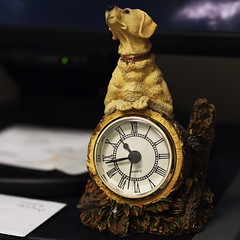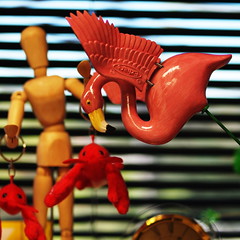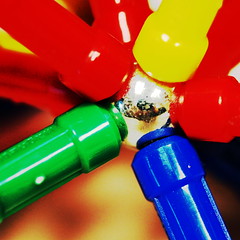Going 6x6 Again
I got a new camera during the Christmas break (essentially a new body to compliment the larger E-3), and I've been shooting with it and the lenses I already had in my kit. The following four photos were all shot with the Olympus ZD 50mm f/2 Macro lens. The body was programmed to shoot a 6x6 aspect ratio.
For those old enough and with memories intact, this is the format of 120/220 format film. Up to this point I had been shooting 4x3 (4:3rds), but I decided to see what it was like to 'go retro' with the aspect ratio.
I had a Mamiya C330 Pro/F in the mid 70's, and shot nothing but 220 black and white with it; primarily Tri-X (ASA 400) with some Plus-X (ASA 125). I'd purchased the body used along with a 50mm (wide angle) and 80mm (normal) lens. I got a lot of good negatives out of that rig. In the end I wound up selling it because I needed the money, a decision I have lamented to this day. With this particular camera I can go back in time as it were and relive those days. What makes it better the second time around is the ability to shoot color or black and white. Right now I'm just enjoying the color side of things.
One important feature of the body is I can lay a cross-hairs on the image as I view it. My C-330 had cross-hairs on its ground glass, so this ability to electronically superimpose them adds to the nostalgia as well as provides a good way for lining up the subject.
Notes on the Photos
Clockwise from upper left:
Everything was shot with available light, and all images came out of the camera as Large Super-Fine (1:2.7 compression) JPEGs. I've gone back to shooting JPEGs exclusively with this body.
For those old enough and with memories intact, this is the format of 120/220 format film. Up to this point I had been shooting 4x3 (4:3rds), but I decided to see what it was like to 'go retro' with the aspect ratio.
I had a Mamiya C330 Pro/F in the mid 70's, and shot nothing but 220 black and white with it; primarily Tri-X (ASA 400) with some Plus-X (ASA 125). I'd purchased the body used along with a 50mm (wide angle) and 80mm (normal) lens. I got a lot of good negatives out of that rig. In the end I wound up selling it because I needed the money, a decision I have lamented to this day. With this particular camera I can go back in time as it were and relive those days. What makes it better the second time around is the ability to shoot color or black and white. Right now I'm just enjoying the color side of things.
One important feature of the body is I can lay a cross-hairs on the image as I view it. My C-330 had cross-hairs on its ground glass, so this ability to electronically superimpose them adds to the nostalgia as well as provides a good way for lining up the subject.
 |  |
 |  |
Notes on the Photos
Clockwise from upper left:
- A shot of a clock my oldest daughter gave me a few Christmases back. The yellow lab is in remembrance of our first yellow Lab, Rhett.
- A shot of some of the widgets that populate my office. In this case, the ubiquitous Florida flamingo is leaning dangerously as if ready to fall.
- On the way home today I had to pick up something at the drug store. I parked right behind a red 2002-2005 Ford Thunderbird. I grabbed a shot of the trunk emblem on the way in. They must have thought I was nuts.
- I got a small Magnetix set back when I was working for SAIC on WARSIM. I've carried that set around with me ever since then. It was a great way to relax when I needed to stop and take a break. In this image I played with the tone curve in post processing using Olympus Master in order to get the pop-art bright colors.
Everything was shot with available light, and all images came out of the camera as Large Super-Fine (1:2.7 compression) JPEGs. I've gone back to shooting JPEGs exclusively with this body.

Getting technical here, there are a variety of formats commonly shot on 120/220 film. 6x6 was probably most commonly associated with Hasselblad, as well as TLRs like the Mamiya C330. More common for walk-around-capable cameras was probably 6x4.5, which I've actually been shooting quite a bit of lately on my Mamiya 645 Pro TL. And then, you can also find a "bigger" series of medium-format cameras and roll-film backs for large-format cameras that'll shoot 6x7 or 6x9.
ReplyDeleteRegardless, one of my biggest gripes with the 35mm-derived formats we're currently used to is that the frame is simple too wide. Sure, if you only post online you might never notice. But the moment you try and get anything printed, none of the common paper sizes get even close to the same aspect ratio.
These days I've actually been shooting a lot of film, mostly 120. The bulk of it was 645 in my Mamiya, but some of it has been 6x7 in a roll back for an ancient Graflex I picked up several months back. Both are capable of producing excellent photographs, and the resolution of MF film (since I convinced myself to buy a Nikon Coolscan 9000) is just astounding. Yes, some of it holds up to the 60+mp range.
So far I've shot the following films:
E-6: Fuji Velvia 100, Fuji Provia 100F
C-41: Kodak Portra 160NC, Kodak Portra 400NC
B&W: Kodak Tri-X 400, Fuji Neopan 400, Fuji Acros 100
Whatever impression people might have when comparing their crappy consumer-grade film developed at a drugstore to modern digital, shooting *good* high-end film and having someone with a clue process it gives a *totally* different result :-)
(Caveat: I've found that my own scans are far better in resolution and exposure than what the good local labs want to charge me $15/roll for, so I just scan myself now.)
That's why I shoot 4:3rds. That aspect ratio is closest to the majority of paper sizes I care about. As for alternate aspect ratios on 120/220 film, 6x6 was by far the most common and 6x6 format cameras the most affordable. 6x45 and 6x7 turned out to be upper-end pro cameras.
ReplyDelete6x6 was actually more associated with Rollei (Rolleiflex) and Yashica TLRs than just about any model. Even Olympus manufactured a TLR during the 1950's. We're talking fixed lens TLRs; the only interchangeable TLR I am familiar with (and owned) was from Mamiya.
I keep wondering if I should get a TLR like a C330 someday, mainly for street photography. The idea, in theory, is that I can take pictures of people while they think I'm just fiddling with the camera. (of course I could do that with my 645 SLR too, if I got a waist-level-finder, but it would make more noise.)
ReplyDeleteThe main reason I haven't done street people photography yet is simply that I feel too awkward snapping photos of random strangers, when they know I'm doing it.